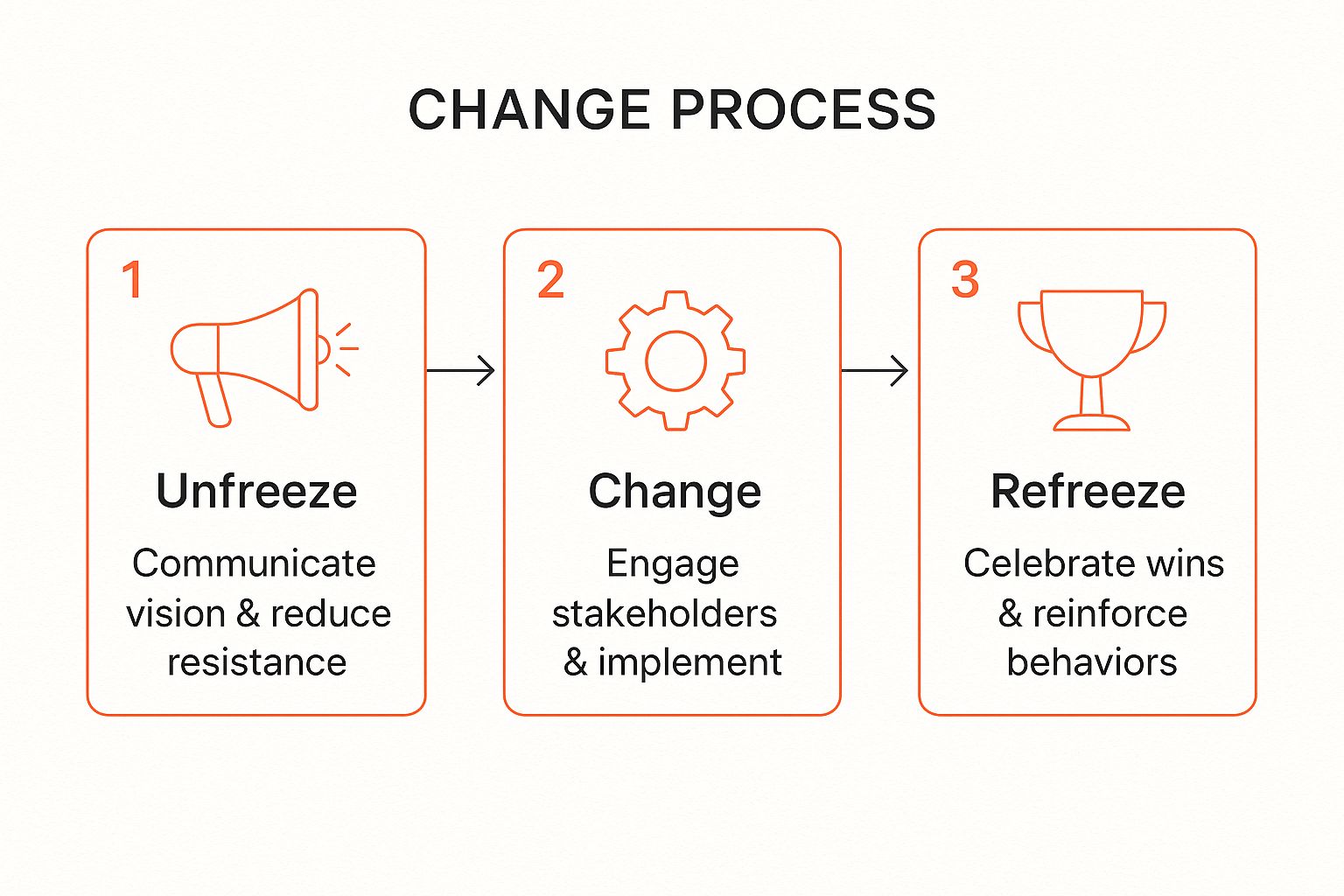Leadership isn't what it used to be. In a world shaped by remote work, AI co-pilots, and constant change, the old playbook just doesn't cut it. Effective leadership training now requires a blend of timeless human skills and modern technological fluency. This isn't just about managing teams; it's about architecting resilient, innovative, and inclusive workplace cultures.
The key is deploying the right training topics for leaders using cutting-edge instructional design. By leveraging tools like AI-driven simulations, microlearning modules hosted on a sophisticated LMS or LXP, and immersive scenarios built with the Articulate Suite or Adobe Captivate, organizations can transform abstract theories into tangible leadership skills.
This guide moves beyond generic advice. We're diving into 10 crucial training topics for leaders, packed with actionable strategies and modern delivery methods to prepare your managers for the challenges of today and tomorrow. Whether you're an instructional designer crafting a new curriculum or a leader looking to upskill, you'll find fresh perspectives to build a more effective development program. Let's get started.
Emotional intelligence, or EQ, isn't just a soft skill; it's a fundamental competency that distinguishes great leaders from average ones. This training topic for leaders moves beyond traditional management tactics to focus on how leaders perceive, understand, and regulate their own emotions while influencing those of their team. High-EQ leaders build psychologically safe environments, navigate conflict with grace, and inspire genuine motivation.

Popularized by thought leaders like Daniel Goleman and Brené Brown, EQ training is about developing self-awareness, empathy, and social skills. For instance, Google's "Search Inside Yourself" program combines mindfulness with EQ to help its leaders thrive under pressure.
Start by establishing a baseline. Use validated assessments like the EQ-i 2.0 to give leaders a clear picture of their strengths and weaknesses. From there, instructional designers can craft a blended learning journey.
Strategic thinking is a critical training topic for leaders, shifting their focus from managing daily tasks to architecting the future. This training equips leaders to analyze market trends, anticipate disruptions, and formulate a compelling long-term vision. Instead of just reacting to change, they learn to proactively shape the organization's direction, ensuring sustainable growth and a strong competitive edge.

Popularized by experts like Michael Porter and Jim Collins, strategic thinking is behind major industry pivots. Think of Netflix moving from DVDs to streaming or Tesla publishing its multi-decade master plan. These leaders didn't just manage their companies; they envisioned and executed a future their competitors couldn't see.
Begin with foundational frameworks like SWOT analysis or Porter's Five Forces, but quickly move to practical application. The goal is to build a strategic mindset, not just theoretical knowledge. Modern instructional design can make this abstract topic tangible.
In today's fast-paced environment, the only constant is change. This training topic for leaders equips them with the skills to guide their teams through transformations, whether they involve new technology, organizational restructuring, or cultural shifts. Leaders learn the psychology behind resistance and develop strategies to build buy-in, communicate with clarity during uncertainty, and maintain morale and productivity.
Effective change leadership, as championed by experts like John Kotter and the Prosci ADKAR model, minimizes disruption and maximizes adoption. Satya Nadella’s famous cultural turnaround at Microsoft from a "know-it-all" to a "learn-it-all" culture is a prime example of successfully leading a massive organizational transition.
To simplify the process, many leaders follow a three-stage model for managing change, as visualized below.

This framework helps leaders structure their efforts, ensuring they first prepare the organization, then implement the change, and finally solidify the new norms.
Start by framing change as an opportunity, not a threat. Use practical models to give leaders a clear roadmap for what often feels like a chaotic process. This is where modern instructional design shines.
This training topic for leaders goes beyond basic public speaking to cultivate the ability to communicate with clarity, confidence, and impact. Executive presence is the blend of gravitas, communication skills, and appearance that allows leaders to command a room and inspire action. Leaders with a strong presence can articulate a compelling vision, navigate difficult conversations, and project authenticity, even under pressure.
Popularized by experts like Nancy Duarte and Carmine Gallo, this training focuses on practical techniques for influence. Think of Indra Nooyi’s strategic communication during PepsiCo's transformation or Barack Obama’s masterful use of storytelling and pauses. To further explore enhancing how leaders connect with their teams and stakeholders, consider resources on effective communication skills training.
Start by recording leaders during a presentation to create a baseline for feedback. This provides a clear, objective starting point for development. From there, build targeted training modules leveraging modern tech.
Effective leaders don't just manage tasks; they build talent. This training topic for leaders focuses on shifting the managerial mindset from being a problem-solver to becoming a talent-developer. Instead of giving answers, leaders learn to ask powerful questions, foster self-discovery, and guide their team members toward unlocking their own potential. This creates a more empowered, capable, and resilient workforce.
This philosophy is championed by experts like Michael Bungay Stanier and Marshall Goldsmith and is put into practice by leading companies. Google’s "Manager as Coach" program and Adobe's "Check-in" system are prime examples of embedding ongoing coaching into the fabric of leadership, replacing outdated annual reviews with continuous development conversations.
The goal is to make coaching a consistent habit, not a rare event. Start by introducing a simple, memorable coaching framework, like the GROW model, and then build practical application skills around it using instructional technology.
Effective DEI leadership is no longer a "nice-to-have" but a core business imperative. This crucial training topic for leaders focuses on building the skills to foster inclusive environments where diverse perspectives are valued and everyone has an equitable opportunity to succeed. It moves beyond compliance to equip leaders to actively dismantle systemic barriers, challenge their own unconscious biases, and leverage diversity as a powerful driver of innovation and performance.
This training is championed by experts like Vernā Myers and Ibram X. Kendi, who reframe DEI from a programmatic task to an ongoing cultural commitment. Companies like Salesforce, which conducts pay equity audits and established a Chief Equality Officer, and Microsoft, with its inclusive hiring program for neurodiverse talent, demonstrate the tangible impact of embedding DEI into leadership and organizational strategy.
Effective DEI training begins with self-reflection and systemic analysis. Leaders must first understand their own perspectives and privileges before they can effectively champion change. From there, the focus shifts to creating equitable systems.
Avoidance is a common tactic for handling conflict, but great leaders run toward it, armed with the right tools. This training topic for leaders equips them with frameworks to navigate workplace disagreements constructively and handle difficult conversations with confidence. Instead of letting issues fester, trained leaders can transform potentially damaging conflicts into opportunities for growth, stronger relationships, and improved team trust.

Popularized by experts like Kerry Patterson ("Crucial Conversations") and Kim Scott ("Radical Candor"), this training focuses on direct, empathetic communication. For example, Pixar's "Braintrust" process institutionalizes critical feedback, while Amazon's "disagree and commit" principle ensures that conflicts lead to decisive action rather than stagnation. These approaches prove that well-managed conflict is a catalyst for innovation.
Start by helping leaders understand their own default conflict style using an assessment like the Thomas-Kilmann Conflict Mode Instrument (TKI). This creates self-awareness and a foundation for skill development.
Great leadership hinges on making high-quality decisions, often under pressure. This training topic for leaders equips them with structured frameworks to move beyond gut feelings and tackle complex challenges with clarity and confidence. It’s about building the skills to analyze problems, evaluate options without bias, and commit to a course of action that drives the business forward.
Popularized by thinkers like Daniel Kahneman and practitioners like Jeff Bezos, structured decision-making is a core leadership competency. Amazon, for example, uses a "one-way door" versus "two-way door" framework to classify decisions by their reversibility, dedicating more rigor to irreversible choices. This approach prevents analysis paralysis and empowers leaders to act decisively.
Start by introducing leaders to common cognitive biases that derail sound judgment. From there, build practical skills using real-world scenarios relevant to your business challenges.
Great leaders don't just manage individuals; they cultivate high-performing teams that are more than the sum of their parts. This training topic for leaders focuses on transforming a group of talented people into a cohesive unit that consistently delivers exceptional results. It's about architecting an environment of psychological safety, shared purpose, and mutual accountability where collaboration thrives.
Popularized by thinkers like Patrick Lencioni ("The Five Dysfunctions of a Team") and Amy Edmondson, this training is backed by real-world success. Google’s Project Aristotle famously found that psychological safety, not individual brilliance, was the top predictor of team success. This training gives leaders a playbook to replicate that dynamic.
Start with a diagnostic. Use a framework like Lencioni's model to assess where the team currently stands regarding trust, conflict, and accountability. This creates a clear starting point for development.
Mastering time management is a cornerstone training topic for leaders, addressing the universal challenge of balancing endless demands. This training moves beyond simple to-do lists to equip leaders with frameworks for prioritizing high-impact activities, protecting focus time, and strategically delegating tasks. The goal is a fundamental shift from being constantly busy to being genuinely productive and effective.
Popularized by experts like Stephen Covey and David Allen, these concepts are about aligning daily actions with strategic goals. For instance, Warren Buffett's "5/25 rule" guides focus on only the top five priorities, while Bill Gates' famous "Think Weeks" exemplify the power of blocking dedicated time for deep, strategic work. To effectively manage demands and align actions with key objectives, leaders can implement robust priority management systems that guide their focus and resource allocation.
Begin by having leaders audit their time for one week to identify where their energy is actually going. This creates a powerful baseline for improvement and highlights discrepancies between intentions and reality.
We've explored a comprehensive lineup of essential training topics for leaders, from the nuances of Emotional Intelligence to the practicalities of delegation. But simply knowing these topics exist is like having a map without taking the first step. The real magic happens when you move from passive knowledge to active, intentional application. Leadership development isn't a "one-and-done" workshop; it's a continuous, evolving journey of growth, both for the leader and their team.
The most impactful takeaway is this: great leadership training is integrated, not isolated. You can’t master change management without strong communication skills, and you can't build a high-performance team without a foundation in DEI and effective coaching. The challenge for instructional designers and L&D professionals is to weave these threads together into a cohesive, engaging learning experience that sticks.
Think about how you can leverage modern learning technologies to bring these concepts to life. Imagine your leaders practicing difficult conversations through an AI-powered simulation that provides real-time feedback. Picture them receiving a timely microlearning video on strategic prioritization, delivered directly through your company's Learning Experience Platform (LXP) right before a major planning session.
You could use tools like the Articulate Suite or Adobe Captivate to build interactive scenarios that challenge leaders to make tough decisions, resolve conflicts, or coach a struggling team member. All of this content, from bite-sized modules to comprehensive courses, can be tracked and managed within a central Learning Management System (LMS), providing valuable data on progress and impact. The goal is to create a learning ecosystem that supports leaders at their moment of need.
Feeling inspired but not sure where to start? Don't try to boil the ocean.
Ultimately, investing in these training topics for leaders is an investment in the health, resilience, and future success of your entire organization. It creates a culture where people feel supported, empowered, and motivated to do their best work. When leaders grow, everyone benefits.
Ready to transform your leadership development strategy from a list of ideas into a high-impact reality? At Relevant Training, we specialize in creating and updating dynamic, custom eLearning content that brings these critical training topics for leaders to life. Let's connect and build a program that drives real performance and engagement for your team.